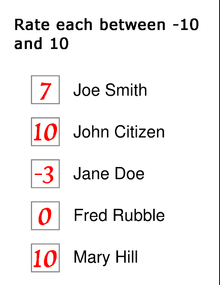Cardinal voting systems
| Part of the Politics series |
| Voting systems |
|---|
|
Plurality/majoritarian |
|
Other
|
|
|
Cardinal voting systems are voting systems which allow the voter to give each candidate an independent rating or grade from among at least two levels of approval. Along with ordinal voting systems (also called ranked voting systems), they are the two main branches of modern voting systems to compete with the venerable simple plurality voting.


.png)
The simplest possible cardinal system is Approval voting, which allows only the two grades "approved" or "unapproved". Other cardinal systems include Range voting, in which ratings are numerical and the candidate with the highest average rating wins; and Majority Judgment, in which ratings are verbal grades and the candidate with the highest median grade wins.
Range voting and cumulative voting systems are other examples of cardinal voting systems. Essentially voters cast multiple approval votes for each candidate or party out of a limited pool. Variants of such systems include disapproval voting options such as negative assignment, but typically out of the same absolute number of votes. That is, a -2 and a +8 add up to ten points, not six, because the absolute value of a negative vote is the same as positive. By avoiding ranking with the implication of a monotonic approval reduction from most to least preferred candidate, cardinal voting systems may solve a very difficult problem.
A foundational result in social choice theory (the study of voting systems) is Arrow's impossibility theorem, which states that no system can comply with all of a simple set of desirable criteria. However, since one of these criteria (called "universality") implicitly requires that a system be ordinal, not cardinal, some have argued that Arrow's theorem does not apply to cardinal systems.[1] Such arguments rest on the idea that cardinality is actually more desirable than passing Arrow's universality criterion. Others, however, argue that this is not true, for instance because interpersonal comparisons of cardinal measures are impossible. If that is the case, then cardinal methods do indeed fail to escape Arrow's result. In any case, cardinal systems do fall under the Gibbard–Satterthwaite theorem, and therefore any such system must be subject to strategic voting in some instances.
References
- ↑ Vasiljev, Sergei. “Cardinal Voting: The Way to Escape the Social Choice Impossibility.” SSRN eLibrary (April 1, 2008). http://papers.ssrn.com/sol3/papers.cfm?abstract_id=1116545.